Think of the words “queer art.” Several faces may be coming to mind already. Amos Mac. Alison Bechdel. Divine. Zoe Strauss. Betty Parsons. Every person mentioned in Le Tigre’s “Hot Topic.”
Norman Rockwell is probably not one of those faces.
Born in 1894, Rockwell would live through two World Wars, the Civil Rights Movement and the first steps on the moon. His art depicts those times in a small town that could be Anywhere, USA. Today, his best-known works are a series of family portraits mirroring President Roosevelt’s Four Freedoms, his Boy Scout manual illustrations, and a pictorialization of America’s favorite butch lady: Rosie the Riveter.
Rockwell’s paintings center around the political, the patriotic, and the traditional–all concepts that queer art enjoys ripping to shreds, restitching into something radical, and topping off with a glittering, sparking bow.
Yet his work is still undeniably…good. You don’t have love baseball and apple pie to appreciate Rockwell’s crazy talent. He was a wholesome storyteller who never had to utter a single word. Before color film became universal, Rockwell brought life to the American experience; each painting is a single priceless moment, freeze framed. As your eyes scan, picking up on little secondary details like a stretched-out sock or a intricate black eye, you feel as if you’re watching a movie instead of staring at hardened paint on a canvas. It’s magically cinematic. And if you look even closer, there’s some interesting commentary on gender. A decade before Rosie, Rockwell was painting the girls who were destined to become riveters.
Underneath all of the red, white and blue, there’s something a little queer going on.
While Norman Rockwell’s primary subjects were men, he also painted a lot of boyish girls. He was given hell for this, especially from other male artists. Coles Phillips once snarked at Rockwell:
Young men and boys. Haven’t you got any guts? You’re young. Haven’t you got any sex? Old men and boys. For Lord’s sake.
As did cartoonist Clyde Forsythe:
You can’t do a beautiful seductive woman. She looks like a tomboy who’s been scrubbed with a washcloth and pinned into a new dress by her mother.
As queer people, we get that gender is never easy. It’s slippery and elusive. One minute, you’ll have it pinned down. The next, it’s slipped away like one of those awkwardly phallic water snake toys you might’ve owned as kid. Home From Camp makes me wonder if I was more certain of who I am when I was ten–scabbed knees and all–than I am now.
According to The Saturday Evening Post, “Rockwell loved the idea of a smug schoolgirl who bested her opponent in a fight.”
Rockwell was no stranger to juxtaposing adolescence with adulthood, but it’s really interesting to see this done with girlhood and womanhood. In Going Out, a grade school-aged girl and her puppy intently watch an older, unquestioningly feminine woman preen for an evening out. Is the girl looking at the woman with eagerness for the day she’s able to assume a similar role, or quiet desperation? Maybe she’s content with her life that consists of puppy dogs and pants. It depends on who you’re asking.
What one person might interpret as excitement for the trappings of womanhood, a genderqueer feminist might read as reluctance.
If any Rockwell portrait says, “I’m not a girl, not yet a [socially normative] woman,” it’s First Evening Gown. Part of art interpretation is projection, and I can’t help projecting all of my childhood memories of being made to wear a dress when I didn’t want to all over this painting; it’s the well-worn penny loafers the girl is wearing versus the crispness of the gown. Did the dress get thrust upon her? Did she beg and plead for the dress? It’s a coming-of-age story with no clear resolution.
“The artist captures the ‘in-between’ age well between the cast away doll and the closer ‘necessities’ of lipstick and hairbrush.” – The Saturday Evening Post
During the war effort, it didn’t matter if you were queer or a woman. If you were of able body, you went to work. A lot of Rosie’s butching up was situational, but no less heroic.
Perhaps Rockwell did have a sixth sense when it came to understanding gender. After all, at a gangly six feet tall and 140 pounds, the artist had firsthand experience with not fitting the mold. In the early 1900s, the “ideal American man” was a brawny guy with a farmer’s tan and crew cut. At 21, Rockwell was denied placement in the US Army because he was deemed underweight. When he was finally admitted, he was assigned artistic duties and never actually experienced the combat for which he’d yearned.
In Anywhere, America, gay is becoming increasingly more okay. If he were still around, how would Norman Rockwell paint our button noses, rainbow flags, and alternative lifestyle haircuts?


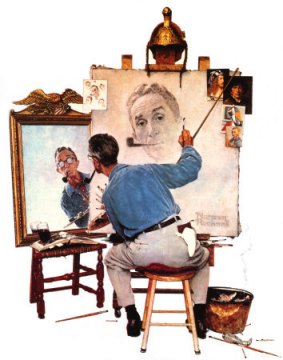
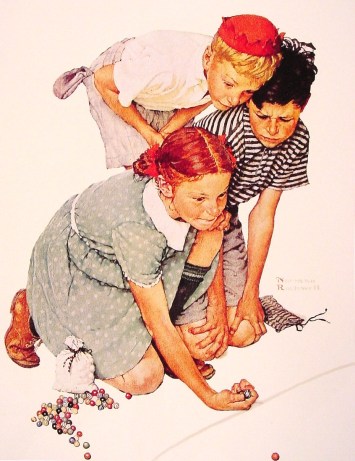
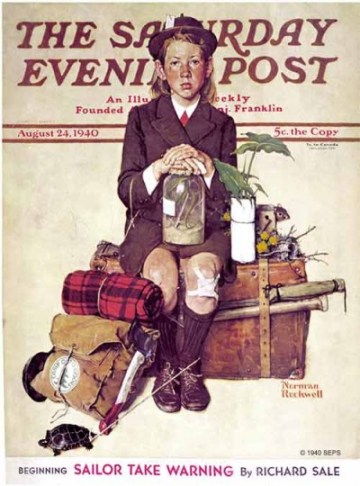
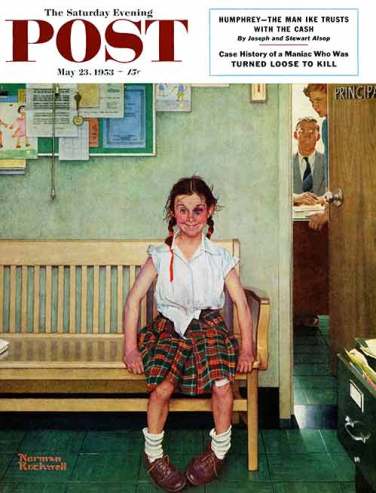
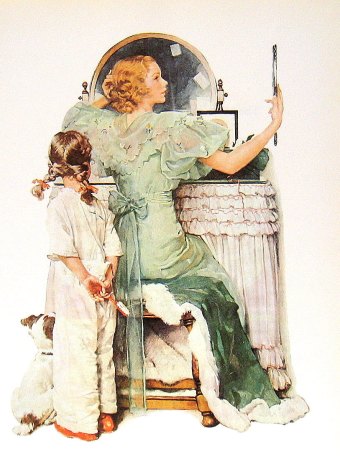
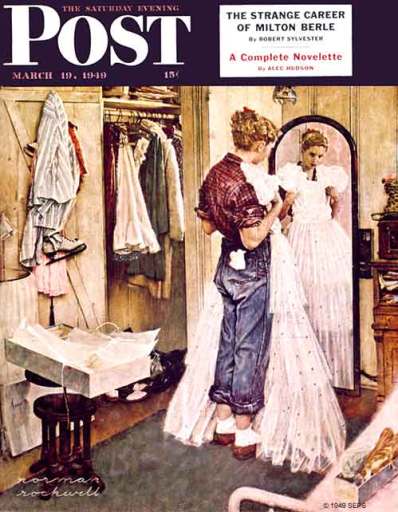
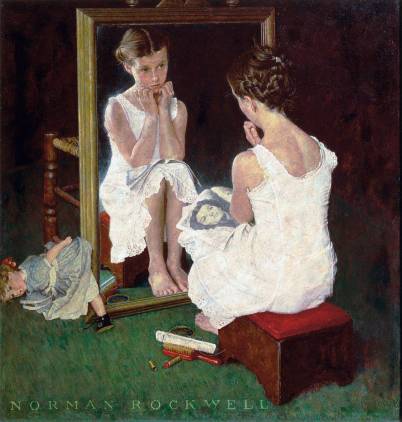
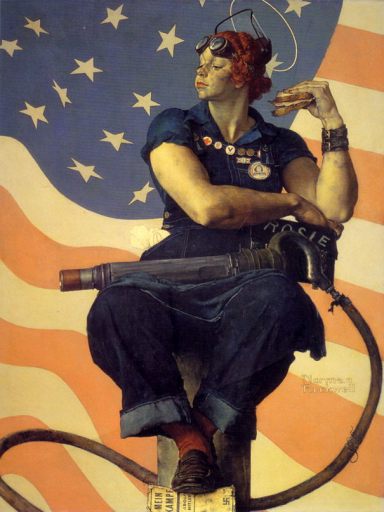

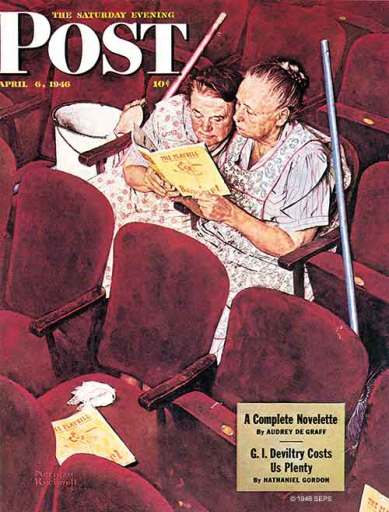

I had no idea Rockwell could paint such moving paintings. Thank you so much!
Interesting perspective on Rockwell and gender, but let’s be real. Rockwell only depicts WHITE “Anywhere, USA.” He paints a kind of race/racism-free nostalgia for a time that wasn’t good at all for POCs.
Not disputing, but check out his painting The Problem We All Live With, which now hangs in the White House. His later work for Look magazine during the 60s was far more political and dealt often with issues of segregation and racism.
Yes, and as a POC I see myself in those pictures – scabby knees, the triumphant look, the interest in makeup, the worn penny loafers (I still wear worn penny loafers). Those pictures dig beyond color IMO.
I guess you don’t know his painting “the problem we all live with”, which he painted to condemn racism in 1964 when a little black girl went to an all-white school for the first time and Americans collectively shat their pants :
http://www.kingsacademy.com/mhodges/11_Western-Art/27_Popular_Modern-Realism/Rockwell/Rockwell_1964_The-Problems-We-All-Share.jpg
I think the “good (white) ol’ times” nostalgia attached to Rockwell’s paintings wasn’t his intent and doing at the time as much as it has been retroactively attached to them in the present days. The guy just painted what he knew, and maybe he didn’t knew much about POCs and their lives because of his life circumstances. You can sure blame the society that made it so, but you can’t really blame the guy for just living his life the way it was set up and painting about it, you know? He was just an artist doing his thing, that doesn’t necessarily makes you an activist at heart.
I think it’s also worth noting that Rockwell was not a fine-artist painting for himself and exposing in galleries, he was mostly a commercial illustrator. One of the reasons most of his paintings represent white people only is probably because he was commissioned to paint white people only.
Not that it’s the most authoritative source.. but wikipedia says that: “The painting was originally published as a centerfold in the January 14, 1964 issue of Look.[3] Rockwell had ended his contract with the Saturday Evening Post the previous year due to frustration with the limits the magazine placed on his expression of political themes, and Look offered him a forum for his progressive social interests, including civil rights and racial integration”.
The source they cite for that isn’t quite as straightforward: http://books.google.co.uk/books?id=FwF-AWzsLIYC&pg=PA124&redir_esc=y#v=onepage&q&f=false
I tend to think that the artists’ intent doesn’t really make or break the judgement about whether something is “white nostalgia” or a whitewashed representation of history. I’m sure Rockwell was a swell guy, and I totally buy that his work was limited by his role as an illustrator for X or Y magazine with Z editor. I just see a whitewashed depiction of history in most of his paintings. And sure, I love that he had some paintings that went against this grain. But his larger body of work, whether he intended or not, is nevertheless an excellent example of white nostalgia, which describes aesthetic works that reminisce about the past while excluding forms of racial oppression that were central to those eras (see Desmond and Emirbayer’s 2009 book on Race and ethnicity in America if you’re interested in seeing some academic support).
http://www.everydaycitizen.com/2008/02/norman_rockwell_and_the_civil.html
Hey. Hi. Hello. Thanks for reading and taking the time to comment. This is a very important point. It’s impossible to not notice that America’s motto during the 1950s was EVERYTHING WAS WHITE, CISGENDER, HETEROSEXUAL AND NOTHING HURT. In looking at Rockwell’s body of work, this is only exacerbated. It mirrors that time he lived in. His work for Look Magazine also reflects the last decades of his life, where white people like Rockwell were forced to (rather awkwardly) address racism. You can’t look at The Problem We All Live With or the hugely underrated New Kids in the Neighborhood without feeling something, be it questioning your own racism or realizing that this shit was very much real. When a person living in “Anywhere, America” in the 20th century picked up The Post or Look, they felt that shit, too. This is why Rockwell was a genius. The fact that he also embraced gender deviancy only makes this more decadent.
PS, You’re talking to a girl who wore long sleeves during the summer when she realized her skin was darker than those of her elementary school peers. My Cuban father was no Willie Gillis, but his arms mirror those of the subject of The Tattoo Artist nonetheless.
As a person of color, I’m proud that The Problem We All Live With has taken up residence in the White House. It’s visibility. For women, for people of color, and America’s unseemly past. And good art. Yes. Never forget the art.
xxxo!
Also, a fun quote from a Rockwell biography that I didn’t use in this piece:
“As a young art student, Rockwell defended the presence of women in illustration classes when a sexist colleague attacked the idea.”
– From The Underside of Innocence by Halpern
http://www.pophistorydig.com/?p=9780
If you think Rockwell didn’t care about race, think again.
Not true at all! I know I’m a a few years late here, but Rockwell actually painted more people of color most other illustrator of his time. Look up ” The Problem We All Live With” he painted that in ’64, in no way does that hide racism. Or, Freedom of Worship, or Moving Day, or The Golden Rule. His paintings are obviously idealistic, not really showing true America, and being a white man, living in New England, his subjects are limited, but i think he deserves some credit.
Actually, once Rockwell was well aware that his paintings didn’t reflect everyone’s experiences. He eventually quit his long-running Saturday Evening Post job so he could paint more truthful pieces, and did a series of paintings in 1964 with scenes from the Civil Rights movement. http://www.msmuseumart.org/index.php/exhibitions/exhibition/norman-rockwell-murder-in-mississippi
I would love to see a queer Thanksgiving dinner a la Rockwell– the microexpressions of familial tensions and butches who can cook would be FRAMED IN MY KITCHEN.
Loved the portraits you pulled for this piece, especially Home from Camp.
I totally printed that picture of the women repairing the car! great post.
I love, love, love this post. Such an interesting, different look at an artist that many of us take for granted. This is my favorite kind of post! It reminds me of a Radiolab for some reason.
My Southern Belle of a great-grandmother had a huge print of Triumph and Defeat hanging on the wall of my bedroom in her house, which had previously been my grandmother’s bedroom, with a photo of my grandmother as a kid tucked in the frame, and then one of me at the same age tucked in next to it. She never really said anything about it, it was a just a quiet reminder that I was allowed to be a rough-and-tumble kid, not adhering to proper and rigid gender roles, while in her house.
She and her husband had put the print up when my grandmother was in college.
Quiet feminism. That’s how I always viewed Rockwell’s paintings of girls. And I think that’s how my great-grandmother used them.
I love these stories because they’re unique and common at the same time. I was introduced to Rockwell through calendars as a child. My bank gave them out for free each January, and my mom never threw them away. Because you just don’t throw away art.
I still have a post card with Triumph and Defeat on the front that my aunt sent to me after a summer visit at her house. I had spent most of the summer playing baseball with her 3 sons and the youngest beamed me right in the eye, playing catch. I was so damn proud of that black eye, and she was proud to have a niece that loved her rough and rowdy boys so much.
I think it’s optimistic to say he would have painted queerness as it is today…but I do think this article makes a good point of finding the ambiguities and little queer moments within a very mainstream artist’s work. Fascinating!
Hell Yes! Thanks for this.
Awesome awesome post. I went to a Rockwell exhibit once as a kid and loved it, and continue loving a lot of his work as an adult.
I think it’s a true sign of how good he is when I look at his work and feel like I’m looking at a reflection of myself. Talk about making art relatable…
Excellent article. I’ve always admired Rockwell’s talent, but I never really paid close attention to his work.
I love Norman Rockwell!!! We share a birthday. WHAT WHAT?
I’ve always loved Norman Rockwell prints/paintings. In the context of his time, Rockwell’s work is pretty transgressive. I have his version of Rosie the Rivetter framed in my living room–I’ve always loved it more than the standard “Rosie” with the bandana. In Rockwell’s version Rosie is the epitome of tough femininity (she even has what look to be political/union buttons on her overalls!).
Yes, she has muscles! She’s burly, stocky; and because she’s so deviant, it’s totally hot.
now i want to go back to the norman rockwell museum and pay closer attention. my mom is obsessed with it so that shouldn’t be too difficult. really interesting take on this, fonsexxxa — thank you for making me see a small aspect of the world a little bit differently than i did when i woke up this morning.
The one with the girl in pigtails with a black eye hung by the dessert line at the Home Town Buffet where my grandparents would take us out to eat and mesmerized me throughout my childhood.
Completely unrelated to the theme of this post but I just have to say it: the dark haired boy in Marble Champion is my Dad. No shit!
omg digger. rockwell’s models are just as fascinating as his work.
Wait seriously??
WOAH
So cool! Story please!
My Grandfather had gotten injured on the job amd was out of work for a bit. My Grandmother saw an ad placed by Harold Anderson, one of Rockwell’s peers. He was looking for child models. My Dad and his sister were both used frequently by both Rockwell, Anderson and a few others. We have all kinds of magazine ads and other prints featuring my Dad, but the only Rockwell we have a copy of is Marble Champion. He and his sister supported the family for a few years, and it was the money they made that enabled all three kids to go to college.
No shit?! That’s a great story!
That’s fantastic, and it must have felt so good for your dad to be able to contribute to your family that way!
I don’t think I’ve ever actually seen any Rockwell work before this post. If I have, I never paid it much attention. These are cool, though. I’d love to have prints of a couple of them.
There’s a great Rockwell print of a cowboy, looking like the ultimate John Wayne type; tough, lined face, square jaw, worn leather, the whole bit–and he’s getting his make-up touched up, because he’s an actor on a movie set.
I saw it at a Rockwell show at the National Portrait Gallery in DC. I think that particular print, and maybe all the prints in the show, were loaned out from Steven Spielberg’s collection. I have a soft spot for representational art, illustrative art that tells a specific story. See Augustus Leopold Egg for the early Victorian version, plus HIS NAME which belongs in a Dickens book. One of the things I like about it is the degree to which the best pictures are a lot like Hollywood blockbusters, just amazingly compressed into a single image. Widely appealing, sentimental, a little bit humorous, have a message but not a complicated or difficult one, tell a clear story about the characters in the picture, moralizing in a conventional and unchallenging way, etc.
Yesterday, I decided to go as Rosie the Riveter for Halloween. This article is both timely and delightful!
OOH this is a really good idea, where do you live so i can decide whether or not it’s ok to totally rip you off?
Hey, have at it! I’m in Dallas, and I’ll be decked out at the enormous block party in the gayborhood. :D
The Crystal Bridges Museum of American Art has a Rockwell exhibit right now that has “Rosie” in it. I’m dying to visit.
this is a really cool article! also, fun sidenote: at the assisted living facility where i work, we have a big book of norman rockwell prints, and i used “girl at mirror” for storytelling. the residents made up a story about how the girl in the picture was getting ready for her date and tore her dress and blamed the tailor and then the tailor was her boyfriend…it was not a queer story in the least but it was pretty funny. i do like thinking about these paintings from a queer perspective though!
My sister and I are taking my mom to the Norman Rockwell exhibit here at the Birmingham Museum of Art for her birthday- so excited! My parents have “Thanksgiving” hanging above their dining room table and I always liked to pretend that the man in the bottom right hand corner was looking at us…kinda creepy now that I think about it, but it was fun as a kid to look at all the expressions.
kickass article, Fonseca. and more proof that almost everything looks better through a queer lens. or more interesting, at least.
So cool. I never took the time to study Rockwell. I enjoyed reading this!
That “Triumph and Defeat” picture reminds me of a photo my mom showed me of herself from her school days. It was a official class photo but she had a big bruise and was looking down because she was messing with a band-aid on her knee, which she had cut up from playing too rough the day before.
Even more than queerness or gender issues, I am struck by the humanity of these pictures. The stories the pictures tell just seem very realistic, very human.
On Home from camp :
How is it that a free-spirited ten year old has more self-confidence than a thirty-two year old adult?
I got up the nerve to ask a girl I had a crush on if she would be my best friend. I had a pair of boots that made me feel bad-ass when I ran around the yard with my forsythia-wood bow and arrows and my rubber band gun my brother and I fabricated with a coping saw off a pattern in a book of DIY depression-era toys. The swing in the apple tree was my own personal Centaur. I could drive a covered wagon and outrun wild horses. I had a real pocket knife. I didn’t cry when I cut myself. Our password to enter the Highland fortification was “Freedom from Tyrants.” Where did all that bravado go? Recently, I have been attempting to reclaim that self assurance and sense of adventure.
Nice article. Thanks.
Norman Rockwell’s been my favorite artist since elementary school. Absolutely loved the article :)
I’ve always admired Rockwell, but I’d never seen “fixing a flat” which is an AWESOME piece of art! I WANT IT.
Pingback: A break from the essays | works and progress
The first time I saw Rosie was in person, at age 14. Until then I’d thought of Rosie the Riveter as only the woman from the “We Can Do It” poster, and seeing Rockwell’s massive portrait celebrating the daily routines of an undeniably butch woman made me feel a lot of things. I’d finally started to identify as not straight (as opposed to “not yet straight” which is basically what I did in grade school), and seeing Rosie was one of the first times I really believed it was possible for women to lead lives that were all at once fulfilling, unconventional, and down to earth. That painting represented historical precedent for women like me existing without being constantly at war with the world, and it was proudly displayed in the center of the room. It said that I wouldn’t have to spend my entire life either hiding or fighting: existing as a person with everyday joys and worries was finally presented as an option. In a lot of ways, seeing that painting represented the point when I realized I was going to make it through life as a queer person, and whatever that would mean would be okay.
Of course a lot of those realizations just happened to occur around that point in my life, but that painting, and Rockwell by extension, mean a lot to me. Rosie symbolizes the realization that, as a queer person, I didn’t have to be at war with the universe. Norman Rockwell might not be terribly related to the rest of the content Autostraddle produces, but it seems like we’ve all got a lot of feelings about his work, and I’m glad I spent some time reflecting on my relationship with his work.
I’m way late to the party, but I really enjoyed this article and can’t resist adding this link to an article that explores Rockwell’s sexual orientation, among other things.
“Was Rockwell gay, whether closeted or otherwise? In researching and writing this biography over the past decade, I found myself asking the question repeatedly.
Granted, he married three times, but his marriages were largely unsatisfactory. The great romance for Rockwell, to my mind, lay in his friendships with men, from whom he received something that was probably deeper than sex.”
http://www.smithsonianmag.com/arts-culture/inside-americas-great-romance-with-norman-rockwell-22055/
I always felt like that about Rockwell, it makes me happy that I’m not the only one :)
Nice. Thank you for sharing with us!!
GMA Network and TV 5 also provides them entertainment and enjoyment with the excellent stories of their https://pinoylambingan.mobi/ Pinoy Teleserye.
your tambayan pinoy tv network will be the best platform of pinoy replays.They believe that pinoy movies tv bring you one step closer to your family
Stay connected to watch and download the latest Pinoy Tambayan and Pinoy Tv Shows. Bookmark our web to watch Tonight With Boy Abunda on pinoy tv tambayan replay
My great-grandfather was a model for Norman Rockwell, and growing up we had a sketch he had done of my great-grandfather in drag hanging on the wall of our living room. Of course Norman Rockwell’s art was rather traditional, but it also played with gender within the constraints of when and where it was made in a way that feels very relevant to queer people living in rural or more conservative regions of the US — a lot of us were once scabbed-kneed fighting tomboys, and, long before red were born, he showed that and normalized it. Glad to read others saw what I did :)